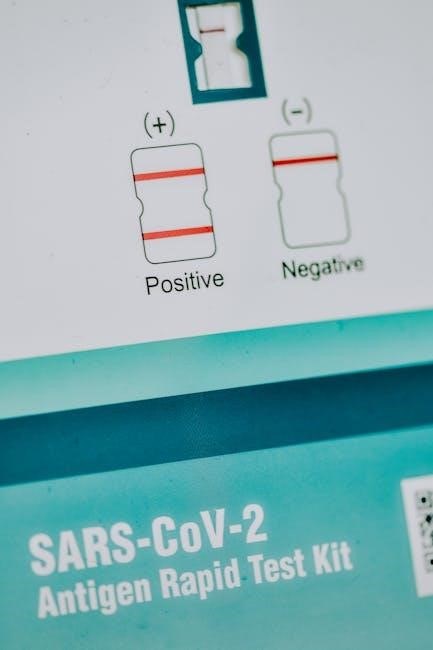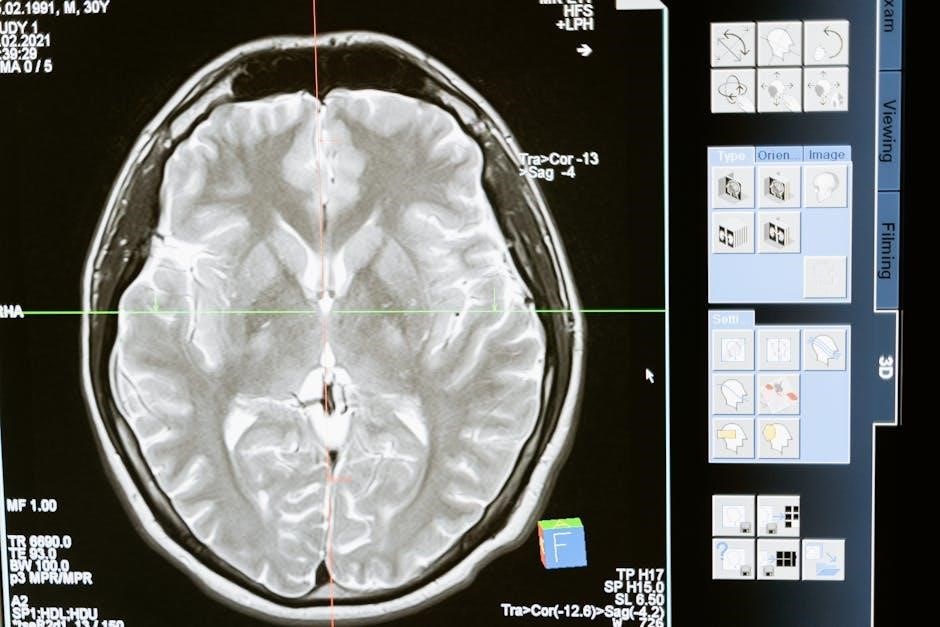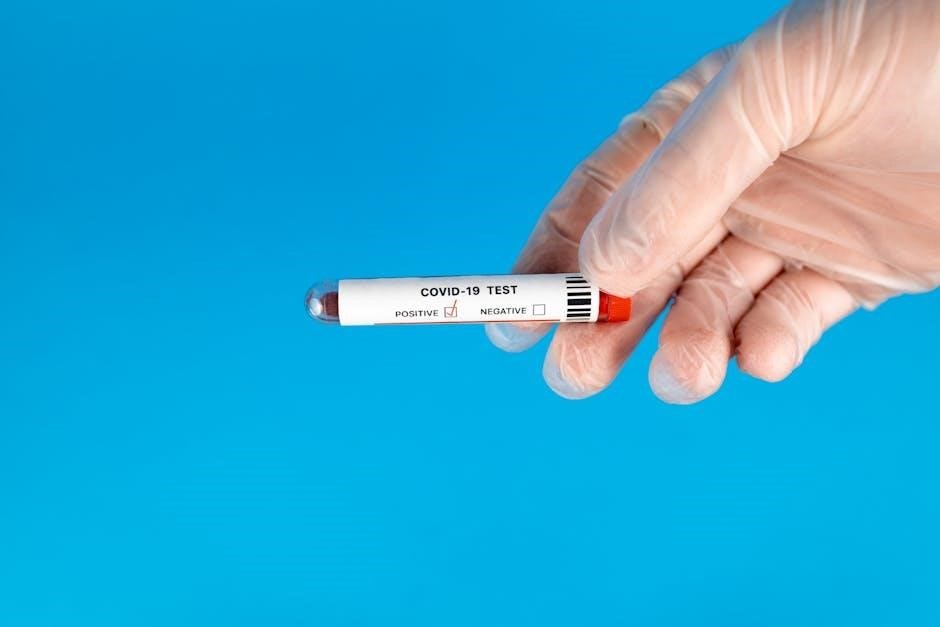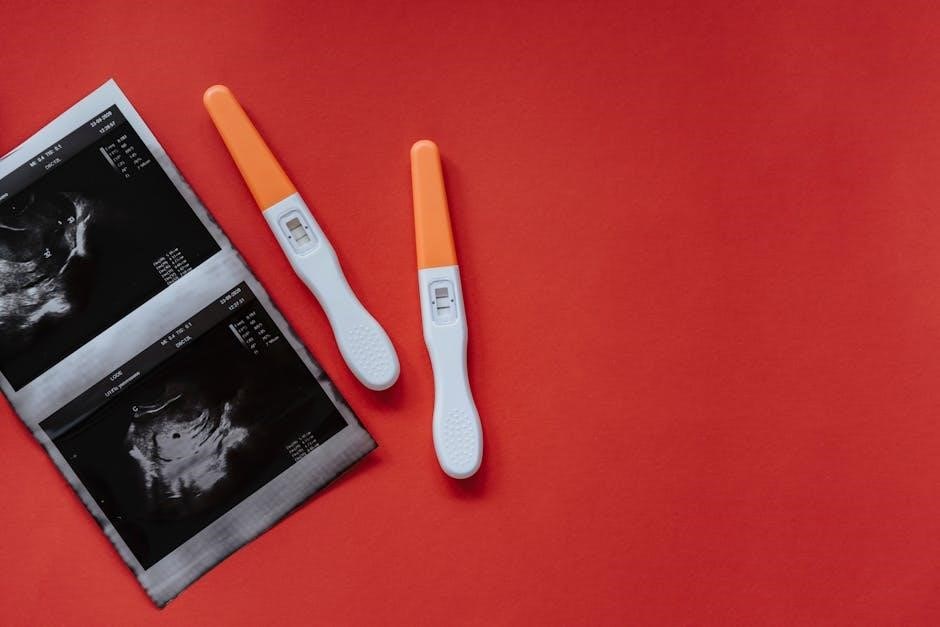
A negative STD test result indicates no detection of the tested infection, providing peace of mind. Understanding this result is crucial for maintaining sexual health and preventing misinformation. Accurate results depend on proper timing and test sensitivity, while PDF templates offer a clear, confidential way to access and share your results securely.
Understanding Negative STD Test Results
A negative STD test result means the specific infection was not detected in your sample. This could indicate you don’t have the infection or the test was taken too early. False negatives can occur if testing happens before the infection is detectable, typically within the “window period.” Understanding this is crucial for accurate interpretation. Results are often provided in PDF format, ensuring clarity and confidentiality. A negative result does not guarantee immunity or protection from future infections, so regular testing is recommended based on risk factors. Always consult a healthcare provider if symptoms persist or if you suspect exposure, as follow-up testing may be necessary for confirmation. Accurate timing and test sensitivity are key to reliable outcomes.
What Does a Negative STD Test Result Mean?
A negative STD test result indicates that the specific infection tested for was not detected in your sample. This means no evidence of the targeted bacteria, virus, or antibodies was found. However, a negative result does not guarantee complete immunity or rule out other infections. False negatives can occur if testing is done too early, during the “window period,” before the infection is detectable. It’s important to follow testing guidelines and timing to ensure accuracy. A negative result also does not imply protection against future infections. Regular testing is recommended based on individual risk factors. Always consult a healthcare provider for interpretation and further guidance if needed.
Common Terminology Used in STD Test Results
Understanding common terminology in STD test results is essential for clear interpretation. Terms like reactive or positive indicate the presence of an infection, while non-reactive or negative suggest the absence of the tested infection. Not detected means the bacteria or virus was not found in the sample. A false negative occurs when the test incorrectly shows no infection, often due to early testing. Reference range refers to the normal or expected values for a test. Threshold indicates the level at which a result is considered positive. Sensitivity and specificity measure a test’s accuracy. Familiarizing yourself with these terms helps in accurately interpreting your results and making informed decisions about your health.

Interpreting Your Negative STD Test Results
A negative result means no infection was detected, but timing and test sensitivity can affect accuracy. Understanding terms like “non-reactive” and “false negative” ensures proper interpretation of your results.
How to Read and Understand Your Test Results
Reading your negative STD test results involves interpreting key terms like “non-reactive” or “not detected.” These terms indicate the absence of the tested infection. Ensure you review the report for all tested STDs, as results may vary between infections. The PDF format provides a clear layout, making it easier to identify each section. Pay attention to any notes about testing windows or false negatives, as early testing may yield inaccurate results. If unsure, consult a healthcare professional for clarification. Understanding each component ensures you grasp the full meaning of your results and take appropriate next steps for your health.
Key Components of a Negative STD Test Result PDF
A negative STD test result PDF typically includes patient information, test details, and clear result indicators. It lists the specific STDs tested, such as chlamydia or gonorrhea, with results marked as “non-reactive” or “not detected.” Reference ranges and test dates are also provided for transparency. The PDF may explain terms like “false negatives” and testing windows to ensure understanding. A summary section highlights negative results for easy review. This structured format ensures clarity and confidentiality, making it easier to share with healthcare providers or partners if needed. The PDF’s organization helps individuals quickly grasp their status and take appropriate next steps confidently.
Understanding the Difference Between Reactive and Non-Reactive Results
In STD test results, “reactive” and “non-reactive” are key terms. A reactive result means the test detected the presence of an STD, indicating a positive diagnosis. Conversely, a non-reactive result signifies that no infection was detected. It is important to note that non-reactive does not always mean “negative,” as false negatives can occur if testing is done too early. Understanding these terms helps individuals interpret their results accurately. Reactive results require immediate medical attention, while non-reactive results may need follow-up testing to confirm accuracy. This distinction is crucial for proper diagnosis and treatment, ensuring timely care for those infected and peace of mind for others. Always consult a healthcare professional for clarification.

The Importance of Accurate STD Test Results
Accurate STD test results are crucial for proper diagnosis, treatment, and prevention of further transmission. They ensure timely medical intervention and prevent complications from undetected infections.
Why False Negatives Can Occur and How to Avoid Them
False negative STD test results can occur due to premature testing, where the infection is not yet detectable. Timing is critical, as antibodies or viral loads may not be present in early infection stages. Improper sample collection or lab errors can also contribute. To minimize false negatives, adhere to recommended testing windows, ensure proper sample collection, and use highly sensitive tests. Repeat testing is advised if exposure is suspected but results are negative. Understanding these factors ensures accurate results, preventing undiagnosed infections and promoting timely treatment. Always consult a healthcare provider for interpretation and guidance to avoid misunderstandings and ensure proper care.
The Role of Testing Windows in Ensuring Accuracy
Testing windows play a critical role in ensuring the accuracy of STD test results. A testing window refers to the time frame after potential exposure during which a test can reliably detect an infection. Testing too early, before antibodies or viral loads reach detectable levels, can lead to false negatives. For example, HIV tests may require a 4-6 week window, while chlamydia and gonorrhea tests may need a shorter period. Adhering to recommended testing windows ensures that results are accurate and reliable. Ignoring this timeframe may result in undiagnosed infections, emphasizing the importance of timing in STD testing. Always consult a healthcare provider for guidance on appropriate testing timelines to avoid misleading outcomes.

How to Obtain Your Negative STD Test Results
Accessing negative STD test results is straightforward via secure online platforms or healthcare providers. Results are typically available as downloadable PDFs, ensuring confidentiality and ease of sharing with medical professionals or partners, while maintaining your privacy and peace of mind. Digital access streamlines the process, making it efficient and user-friendly for individuals to retrieve their test outcomes promptly.
Methods for Receiving Your Test Results
Receiving negative STD test results can be done through various secure methods. Many healthcare providers offer online portals where results are available as downloadable PDFs, ensuring confidentiality and convenience. Some services provide results via email or mobile notifications, while others may require in-person collection. Additionally, platforms like airSlate and pdfFiller allow users to access, edit, and manage their results digitally. These methods prioritize privacy, with encrypted systems protecting sensitive information. Regardless of the method chosen, ensuring the results are accessed securely is paramount to maintaining confidentiality. Digital solutions simplify the process, enabling individuals to retrieve their results efficiently and share them with healthcare providers if needed.

How to Access Your Results Online
Accessing your negative STD test results online is a straightforward process. Most healthcare providers offer secure online portals where you can log in using your credentials. Once logged in, navigate to the “Results” or “Lab Reports” section. Your results are typically available as downloadable PDFs, ensuring easy access and sharing with healthcare providers. Some services also offer results via email or mobile notifications. Platforms like airSlate and pdfFiller allow you to edit and manage your results digitally. Always ensure your connection is secure and use strong passwords to protect your sensitive information. If you encounter issues, contact customer support for assistance. Digital access provides convenience and confidentiality for managing your health records.
Steps to Download Your Negative STD Test Results PDF
To download your negative STD test results as a PDF, start by logging into your secure online health portal using your credentials. Once logged in, locate the “Results” or “Lab Reports” section. Find the specific test you underwent and click on it to view the details. Many platforms provide a “Download” or “Print” option, which allows you to save the results as a PDF file. Ensure your device is connected to a secure internet connection to protect your data. After downloading, save the file in a private folder or cloud storage for easy access. Platforms like airSlate and pdfFiller also offer tools to edit or share your results securely. Always verify the authenticity of the document before sharing it with healthcare providers or employers.

Creating a Negative STD Test Results Template
A template for negative STD test results should include test details, accuracy rates, confidentiality measures, and follow-up recommendations. Use platforms like airSlate or pdfFiller to design and edit professionally.
What to Include in Your Negative STD Test Results Template
Your template should include patient demographics, test type, collection date, and results interpretation. Clearly state “negative” or “not detected” for each STD tested. Add sections for accuracy rates, false negative risks, and follow-up recommendations. Include confidentiality clauses to protect patient privacy. Provide space for healthcare provider details and test laboratory information. Use clear headings and bullet points for readability. Ensure compatibility with digital platforms like airSlate or pdfFiller for easy editing and sharing. Include instructions for accessing results online and steps for downloading the PDF. Legal disclaimers and contact information for further inquiries are essential. Ensure the template is professional, concise, and user-friendly for seamless documentation.
Designing a Clear and Professional Template
A well-designed template for negative STD test results should prioritize clarity and readability. Use bullet points and clear sections to organize information, ensuring ease of understanding. Include bold headings for key sections like “Patient Information” and “Test Results.” Add visual separators or lines to distinguish different parts of the document. Use a professional font and consistent formatting throughout. Incorporate your healthcare provider’s branding or logo for authenticity. Ensure the template is adaptable to digital platforms, allowing easy editing and signing via tools like airSlate or pdfFiller. Include a section for confidentiality statements to protect patient privacy. Highlight important details like test accuracy and follow-up recommendations. A clean, professional layout enhances both readability and credibility, making the document user-friendly and trustworthy.
Sample Templates for Negative STD Test Results PDF
Sample templates for negative STD test results provide a structured format for presenting test outcomes clearly and professionally. These templates typically include sections for patient information, test details, and results interpretation. Key elements include bold headings, clear result status indicators, and confidentiality statements. Many templates feature fillable fields for customization, allowing healthcare providers to input specific data easily. Tools like airSlate and pdfFiller offer pre-designed templates to streamline the process; These templates ensure consistency and readability, making it easier for patients to understand their results. They also include space for follow-up recommendations and testing windows, ensuring comprehensive communication of negative results while maintaining patient confidentiality and trust. Professional templates are essential for clear and secure result delivery.

Legal and Confidentiality Aspects
Handling negative STD test results requires strict adherence to legal standards and patient confidentiality. Digital platforms ensure secure result delivery, maintaining privacy and compliance with health regulations.
Ensuring Confidentiality of Your Test Results
Protecting the confidentiality of your negative STD test results is essential to maintain privacy and trust. Secure online platforms, such as encrypted PDF documents, ensure that your results are only accessible to authorized individuals. Many healthcare providers use password-protected systems to deliver results, preventing unauthorized access. Additionally, reputable testing services comply with health regulations like HIPAA, safeguarding your personal and medical information. It’s important to verify that the platform you use adheres to these standards to ensure your data remains confidential. Always check for security features, such as two-factor authentication and encrypted connections, when accessing your results online to protect your sensitive health information.
Legal Implications of Sharing Test Results
Sharing your negative STD test results without consent can have serious legal implications. Unauthorized disclosure of medical information violates privacy laws, potentially leading to legal action. In many jurisdictions, healthcare providers are legally bound to protect patient confidentiality under regulations like HIPAA. Sharing such sensitive documents, especially in a PDF format, without explicit consent may result in fines or legal consequences. It is crucial to ensure that any sharing of test results is done with the explicit consent of the individual involved. Always verify the legal requirements in your region before disclosing medical information to third parties to avoid potential legal repercussions and maintain trust and confidentiality.

Handling Negative Test Results
Understanding a negative STD test result is crucial for peace of mind. Ensure timing aligns with testing windows to avoid false negatives. Maintain confidentiality and seek guidance if needed.
What to Do Next After Receiving a Negative Result
Receiving a negative STD test result is reassuring, but it’s important to remain vigilant. Continue practicing safe sexual habits to minimize future risks. Educate yourself on testing windows and understand that timing affects accuracy. If symptoms persist or exposure occurs, consider retesting. Maintain open communication with partners about sexual health. Keep your results confidential and secure, especially when sharing or storing them. If accidentally shared, address the situation promptly to avoid misunderstandings. Use this opportunity to reinforce preventive measures and stay informed about STDs. Remember, a negative result is not a pass to disregard protective practices. Stay proactive about your health and well-being.
Emotional and Psychological Impact of Test Results
Receiving a negative STD test result can bring immense relief, reducing anxiety and stress. However, the process of waiting for results can be emotionally draining, often accompanied by feelings of uncertainty and fear. Accidental sharing of results, as highlighted in some cases, can lead to embarrassment or professional repercussions, underscoring the importance of confidentiality. The psychological impact of testing extends beyond the result itself, affecting mental well-being and relationships. It’s crucial to address these emotions constructively, whether through self-reflection or professional support. Remember, a negative result is not just a medical outcome but also a personal milestone that can influence future behaviors and attitudes toward health and privacy.

Reducing the Risk of False Negatives
Understanding testing windows and ensuring timely testing after exposure minimizes false negatives. Adhering to recommended guidelines and consulting healthcare providers enhances result accuracy and reliability for STD tests.
Best Practices for STD Testing
Best practices for STD testing involve understanding testing windows, ensuring timely detection, and avoiding false negatives. It’s crucial to wait the recommended period after exposure before testing, as early testing may yield inaccurate results. Choosing accredited laboratories and following pre-test instructions, such as avoiding urination for a specified time, enhances accuracy. Confidentiality is key; ensure results are securely accessed, often through encrypted online portals. Regular testing, especially for high-risk individuals, is essential for early detection and treatment. Consulting healthcare providers for guidance on testing frequency and interpreting results is highly recommended. Proper documentation, such as PDF results, ensures clarity and professionalism in maintaining personal health records;
Follow-Up Testing Recommendations
Follow-up testing is crucial for confirming negative STD results, especially if symptoms persist or exposure is suspected after the initial test. For infections like HSV, retesting in 4-6 weeks is recommended if recent infection is suspected but results were negative. Regular testing based on risk factors ensures early detection of potential infections. High-risk individuals should test more frequently, while others may follow annual guidelines. Understanding testing windows is key to accurate results. If unsure, consult healthcare providers for personalized advice. Digital platforms often provide PDF results, making it easier to track and manage follow-up tests. Proper documentation ensures continuity of care and peace of mind.

The Future of STD Test Reporting
Advancements in technology are transforming STD test reporting, with digital health platforms enabling faster, secure access to results. PDF formats ensure clarity and confidentiality, enhancing patient accessibility and care.
Advancements in Test Reporting Methods
Recent advancements in STD test reporting have introduced digital solutions, enhancing accessibility and confidentiality. Online platforms now offer downloadable PDF results, reducing wait times and improving patient engagement. Automated systems ensure accuracy, minimizing human error. Secure portals allow users to access and share results discreetly, while fillable PDF templates streamline documentation processes. Digital health platforms integrate with laboratories, providing real-time updates and personalized notifications. These innovations not only improve efficiency but also empower individuals to manage their health proactively. As technology evolves, the future of STD test reporting promises even greater convenience, transparency, and patient-centric care.
Impact of Digital Health on Test Result Accessibility
Digital health has revolutionized access to STD test results, making them more accessible and convenient. Secure online platforms now provide immediate access to results, eliminating the need for in-person visits. Patients can download their results as PDFs, ensuring confidentiality and ease of sharing with healthcare providers. Digital health platforms also offer notifications, reminders, and educational resources, empowering individuals to take control of their health. This shift reduces anxiety and ensures timely follow-up, while maintaining privacy. The integration of digital tools has transformed how STD test results are delivered, offering a faster, more user-friendly experience that prioritizes patient care and confidentiality.
Leave a Reply
You must be logged in to post a comment.